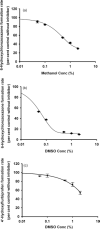Metabolic interactions between acetaminophen (paracetamol) and two flavonoids, luteolin and quercetin, through in-vitro inhibition studies
- PMID: 28872689
- PMCID: PMC6309961
- DOI: 10.1111/jphp.12812
Metabolic interactions between acetaminophen (paracetamol) and two flavonoids, luteolin and quercetin, through in-vitro inhibition studies
Abstract
Objectives: Excessive exposure to acetaminophen (APAP, paracetamol) can cause liver injury through formation of a reactive metabolite that depletes hepatic glutathione and causes hepatocellular oxidative stress and damage. Generation of this metabolite is mediated by Cytochrome-P450 (CYP) isoforms, mainly CYP2E1. A number of naturally occurring flavonoids can mitigate APAP-induced hepatotoxicity in experimental animal models. Our objective was to determine the mechanism of these protective effects and to evaluate possible human applicability.
Methods: Two flavonoids, luteolin and quercetin, were evaluated as potential inhibitors of eight human CYP isoforms, of six UDP-glucuronosyltransferase (UGT) isoforms and of APAP glucuronidation and sulfation. The experimental model was based on in-vitro metabolism by human liver microsomes, using isoform-specific substrates.
Key findings: Luteolin and quercetin inhibited human CYP isoforms to varying degrees, with greatest potency towards CYP1A2 and CYP2C8. However, 50% inhibitory concentrations (IC50 values) were generally in the micromolar range. UGT isoforms were minimally inhibited. Both luteolin and quercetin inhibited APAP sulfation but not glucuronidation.
Conclusions: Inhibition of human CYP activity by luteolin and quercetin occurred with IC50 values exceeding customary in-vivo human exposure with tolerable supplemental doses of these compounds. The findings indicate that luteolin and quercetin are not likely to be of clinical value for preventing or treating APAP-induced hepatotoxicity.
Keywords: CYPs; UDP-glucuronosyltransferase; acetaminophen; drug interactions; flavonoids.
© 2017 Royal Pharmaceutical Society.
Figures






References
-
- Larson AM et al. Acetaminophen-induced acute liver failure: results of a United States multicenter, prospective study. Hepatology 2005; 42: 1364–1372. - PubMed
-
- Miner DJ, Kissinger PT. Evidence for the involvement of N-acetyl-p- quinoneimine in acetaminophen metabolism. Biochem Pharmacol 1979; 28: 3285–3290. - PubMed
-
- Laine JE et al. Acetaminophen bioactivation by human cytochrome P450 enzymes and animal microsomes. Xenobiotica 2009; 39: 11–21. - PubMed
-
- Thummel KE et al. Oxidation of acetaminophen to N-acetyl-p-aminobenzoquinone imine by human CYP3A4. Biochem Pharmacol 1993; 45: 1563–1569. - PubMed
-
- Manyike PT et al. Contribution of CYP2E1 and CYP3A to acetaminophen reactive metabolite formation. Clin Pharmacol Ther 2000; 67: 275–282. - PubMed
MeSH terms
Substances
Grants and funding
LinkOut - more resources
Full Text Sources
Other Literature Sources
Medical

